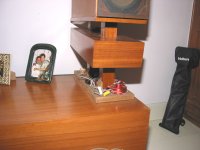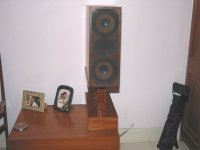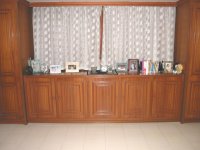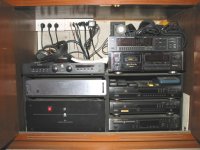Hi all,
I wonder if there is a better place to put the XO, that in the loudspeaker itself (not very practical if you want to tweak the XO)
I was thinking about 2 other places:
directly on the speaker's binding posts (something like a double binding post on the loudepaker, a board with the XO xomponents that plugs into the loudspeaker's posts, and this boards also has posts to connect the wires coming from amp)
or behind the amp, with or without a case
Other ideas?
I wonder if there is a better place to put the XO, that in the loudspeaker itself (not very practical if you want to tweak the XO)
I was thinking about 2 other places:
directly on the speaker's binding posts (something like a double binding post on the loudepaker, a board with the XO xomponents that plugs into the loudspeaker's posts, and this boards also has posts to connect the wires coming from amp)
or behind the amp, with or without a case
Other ideas?
I would guess that if you put it near the amp, you'd have to figure the cable's capacitance and resistance into the crossover (well, I mean realistically you might not). I would think that the optimal place based on sound quality would be as close as possible to the drivers, but I wonder if the voice coils magnetic fields would interfere with the inductors and/or capacitors in the crossover. Personally I've always found it a pain to tweak them since I always put them in the box next to the binding posts.
Anyone have any thoughts?
Pete
Anyone have any thoughts?
Pete
Hi!
There are a lot of people who prefer external passive XOs, because of avoidance of audiophonie-effects (don't know if that is the correct word, in Germany it is called this way) and because of better tweaking possibilities.
With audiophonie-effects I mean mechanical (vibrational) influences on the sound of electrical circuits.
I know people attaching the open XO to the back of their LS, or building a hollow stand in which they put their XOs.
I some way I did it the same: I build a box that consisted mostly of not used volumina (the LS itself only required a very small closed volumina), and I put the XO in the big "stand" of the LS, with a big overlapping piece of wood secured with screws from the back of the LS as a cover (it does not have to be airproof because the LS volumina is totally seperated). That way I can easily reach the XO - which I did not have to do, so far...
Bye,
Arndt
There are a lot of people who prefer external passive XOs, because of avoidance of audiophonie-effects (don't know if that is the correct word, in Germany it is called this way) and because of better tweaking possibilities.
With audiophonie-effects I mean mechanical (vibrational) influences on the sound of electrical circuits.
I know people attaching the open XO to the back of their LS, or building a hollow stand in which they put their XOs.
I some way I did it the same: I build a box that consisted mostly of not used volumina (the LS itself only required a very small closed volumina), and I put the XO in the big "stand" of the LS, with a big overlapping piece of wood secured with screws from the back of the LS as a cover (it does not have to be airproof because the LS volumina is totally seperated). That way I can easily reach the XO - which I did not have to do, so far...
Bye,
Arndt
Well...
Of the two places mentioned, I'd prefer the binding posts. No extra cable involved.
I'd try damping the xover -- despite the fact that it doesn't help post-installation tweaking...
Your other option (amp-side) could mean cable-related losses in parts of the spectrum and two, three cables running the length form amp to speaker...
Of the two places mentioned, I'd prefer the binding posts. No extra cable involved.
I'd try damping the xover -- despite the fact that it doesn't help post-installation tweaking...
Your other option (amp-side) could mean cable-related losses in parts of the spectrum and two, three cables running the length form amp to speaker...
Re: Well...
do you prefer my idea of putting them on the binding posts?
so a card that plugs to the loudspeaker's BP, and had input BP on it ti connect the amp?
This could look clean, but adding more connections isn't a good thing
Gregm said:Of the two places mentioned, I'd prefer the binding posts. No extra cable involved.
I'd try damping the xover -- despite the fact that it doesn't help post-installation tweaking...
Your other option (amp-side) could mean cable-related losses in parts of the spectrum and two, three cables running the length form amp to speaker...
do you prefer my idea of putting them on the binding posts?
so a card that plugs to the loudspeaker's BP, and had input BP on it ti connect the amp?
This could look clean, but adding more connections isn't a good thing
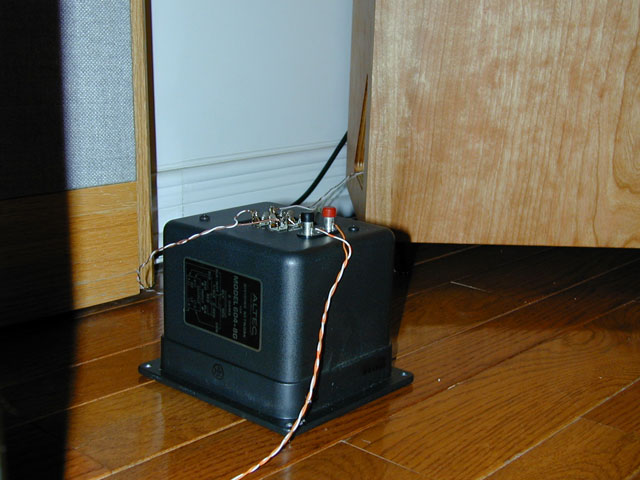
I like outside the box. Since this is a DIY forum, I'm assuming tweaking and trying different configurations is part of the game and you can't beat this configuration for making it easy. I'm using Altec 604's and I'm finding there are countless opinions on how to do a crossover for these - I'm sure I'll go through several designs & component options before I find the one I want to live with long term - I'll then mount it in a pretty box, maybe sand loaded, and leave it beside the speakers. I really don't think there is an issue with a few more feet of speaker wire, at least in the low power SET world I'm in.
On the mechanical/vibration interference thing, I don't know how much this really applies to a passive crossover in a speaker box, but I was amazed at how tapping on some capacitors in a recently completed DIY tube amp could be heard through the speakers. Maybe just tube microphonics but who knows - keeping passive parts out of the giant resonator box just seems like a good idea.
outboard crossovers are preferred
What I did worked real well, I'm sorry I don't have a digital camera.
I put the outboard crossovers on a thin piece of plywood that was cut to fit inside a plastic display box. the plastic display box was about 6" wide by 10" long and 4" tall. This is the same box that is used to display model cars - clear on all sides and a black plastic snug fit recessed bottom. The plastic was easy to work, and it looks slick and professional but is easy to do, and cheap - I think the boxes were around $6.00 US and I bought them on-line - surely there is something similar in Europe.
I ran four speaker wires out of the crossover and in the holes where the bindins posts previously had been and sealed the holes. I left enough wire between crossover box and speaker box to be able to set the crossover on the floor or on top of the speaker cabinet.
I did not use any binding posts and soldered all connections except those at the amp. Somewhat of a purist, but everything you put in the path effects it.
It took me a little while to figure how to attach the top to the bottom securely - that was where piece of plywood came in, I soldered everything on the plywood which was cut the same size as the relieved part of the bottom, and would slide up into the case. Screwed the plywood (I painted the plywood flat black first) to the bottom, and put two screws through the ends of the clear covers into the plywood-
It really does look slick and is about as low-hassle as it comes.
Later
Ken L
What I did worked real well, I'm sorry I don't have a digital camera.
I put the outboard crossovers on a thin piece of plywood that was cut to fit inside a plastic display box. the plastic display box was about 6" wide by 10" long and 4" tall. This is the same box that is used to display model cars - clear on all sides and a black plastic snug fit recessed bottom. The plastic was easy to work, and it looks slick and professional but is easy to do, and cheap - I think the boxes were around $6.00 US and I bought them on-line - surely there is something similar in Europe.
I ran four speaker wires out of the crossover and in the holes where the bindins posts previously had been and sealed the holes. I left enough wire between crossover box and speaker box to be able to set the crossover on the floor or on top of the speaker cabinet.
I did not use any binding posts and soldered all connections except those at the amp. Somewhat of a purist, but everything you put in the path effects it.
It took me a little while to figure how to attach the top to the bottom securely - that was where piece of plywood came in, I soldered everything on the plywood which was cut the same size as the relieved part of the bottom, and would slide up into the case. Screwed the plywood (I painted the plywood flat black first) to the bottom, and put two screws through the ends of the clear covers into the plywood-
It really does look slick and is about as low-hassle as it comes.
Later
Ken L
Hello,
The best place there is to put speaker crossovers is between the preamp and the power amp (bi/tri amping), but i know thats not one of the options. If you want to go with a passive type crossover between the amp and the speaker , I'd have to say that in theory anywhere you can isolate from the vibrations and keep the parasitic capacitance and resistance low will be as good as you can get. Dont expect any huge differences though. Unless you have microphonic crossover parts or an amp that is unstable with some loads, there probably wont be any differences to hear.
-Chris
The best place there is to put speaker crossovers is between the preamp and the power amp (bi/tri amping), but i know thats not one of the options. If you want to go with a passive type crossover between the amp and the speaker , I'd have to say that in theory anywhere you can isolate from the vibrations and keep the parasitic capacitance and resistance low will be as good as you can get. Dont expect any huge differences though. Unless you have microphonic crossover parts or an amp that is unstable with some loads, there probably wont be any differences to hear.
-Chris
Good thread.
When I build my speakers I am going to have an external crossover in my rack. And, I'm going to make the thing look damn pretty! It'll be a work of art, Goddammit!
I see a slim box of standard component width with a see-thru top so my guests can see my handywork I see a crossover set out in a structured manner, much the same as a crossover circuit diagram. yes, granted, a little more work, but, oh, so lovely
I see a crossover set out in a structured manner, much the same as a crossover circuit diagram. yes, granted, a little more work, but, oh, so lovely  )
)
Now let's get serious. What 's the deal with putting a non-shielded XO in the rack, say, only 300mm (12") away from the preamp or power amp?
And what's all this crap (above) about losses if the signal is split at the amp end as opposed to the speaker end? I mean, isn't this happening with bi-amping anyway, and to a certain extent with bi-wiring? C'mon!
Mos
External Crossover Fetish Exponent (ECFE)
When I build my speakers I am going to have an external crossover in my rack. And, I'm going to make the thing look damn pretty! It'll be a work of art, Goddammit!
I see a slim box of standard component width with a see-thru top so my guests can see my handywork
Now let's get serious. What 's the deal with putting a non-shielded XO in the rack, say, only 300mm (12") away from the preamp or power amp?
And what's all this crap (above) about losses if the signal is split at the amp end as opposed to the speaker end? I mean, isn't this happening with bi-amping anyway, and to a certain extent with bi-wiring? C'mon!
Mos
External Crossover Fetish Exponent (ECFE)
Hi!
Take a look at this picture of an external XO at Thel's site...:
Bye,
Arndt
Take a look at this picture of an external XO at Thel's site...:
An externally hosted image should be here but it was not working when we last tested it.
Bye,
Arndt
when the doors open....the amps are fan cooled once the temp gets to 55deg C and there are 2 vents that you guys cant see in the photos one from below the electronics cabinet and one behind...this keeps everything discreete but the main speakers. the subs face rear so all one sees are 2 boxes (each 30"Wx24"Dx18"H).
Attachments
- Status
- This old topic is closed. If you want to reopen this topic, contact a moderator using the "Report Post" button.
- Home
- Loudspeakers
- Multi-Way
- What's the best place to put the crossover?
